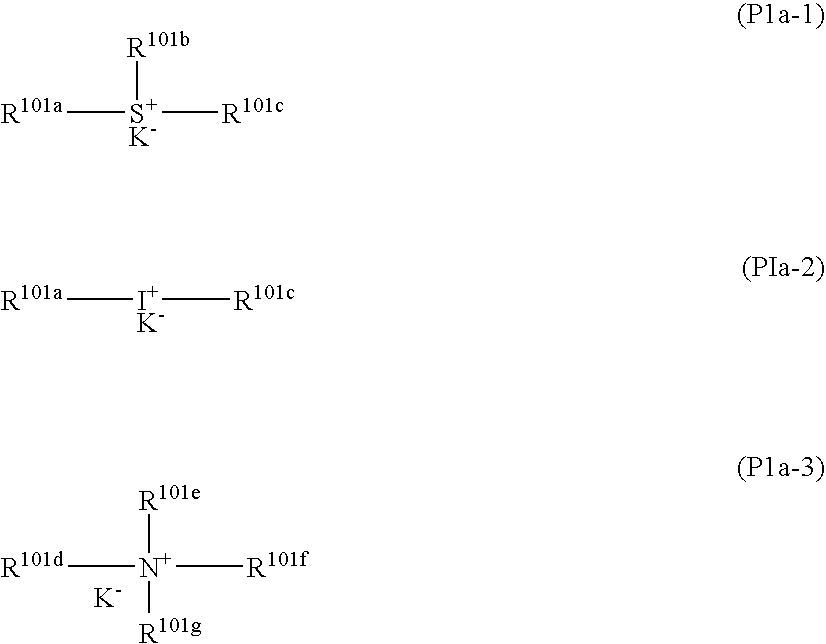Silicon-containing film forming composition, silicon-containing film serving as etching mask, substrate processing intermediate, and substrate processing method
a technology of silicon-containing film and etching mask, which is applied in the direction of photosensitive materials, instruments, photomechanical equipment, etc., can solve the problems of pattern collapse, resist film damage during the processing of substrate, patternable substrate etching, etc., and achieve satisfactory antireflective effect, easy to obtain, and sufficient absorption
- Summary
- Abstract
- Description
- Claims
- Application Information
AI Technical Summary
Benefits of technology
Problems solved by technology
Method used
Image
Examples
synthesis example 1
[0300] A 300-ml glass flask was charged with a mixture of 27 g of tetraethoxydimethyldisilane and 23 g of triethoxytrimethyldisilane and 10 g of ethanol. With stirring, 15 g of 0.5N hydrochloric acid aqueous solution was slowly added at room temperature. Agitation continued for a further 2 hours. After the complete consumption of monomers was ascertained by GC and GPC, 350 g of propylene glycol monomethyl ether (PGME) was added. The liquid mixture was subjected to solvent exchange under a reduced pressure while heating the liquid at 40° C. There was obtained a PGME solution of Polymer 1. The yield of the polymer was determined by taking a predetermined amount of the solution, drying it on a dryer at 150° C. for one hour, and measuring the residue after evaporation. The yield was 100%. This suggests that all the reactants charged in the reactor are converted into a polymer. Accordingly, the silicon content and L / (L+M+N) in the polymer were determined from the charge composition. Data...
synthesis example 2
[0301] A 300-ml glass flask was charged with 27 g of tetraethoxydimethyldisilane, 23 g of triethoxytrimethyldisilane, 21 g of tetraethoxysilane, 7 g of 2-(3,4-epoxycyclohexyl)ethyltrimethoxysilane, and 10 g of ethanol. With stirring, 30 g of 0.5N acetic acid aqueous solution was slowly added at room temperature. Agitation continued for a further 2 hours. After the complete consumption of monomers was ascertained by GC and GPC, 350 g of ethyl lactate (EL) was added. The liquid mixture was subjected to solvent exchange under a reduced pressure while heating the liquid at 40° C. There was obtained an EL solution of Polymer 2. The yield of the polymer was determined by taking a predetermined amount of the solution, drying it on a dryer at 150° C. for one hour, and measuring the residue after evaporation. The yield was 100%. This suggests that all the reactants charged in the reactor are converted into a polymer. Accordingly, the silicon content and L / (L+M+N) in the polymer were determin...
synthesis example 3
[0302] A 300-ml glass flask was charged with 27 g of tetraethoxydimethyldisilane, 23 g of triethoxytrimethyldisilane, 14 g of methyltrimethoxysilane, 48 g of 2-(3,4-epoxycyclohexyl)ethyltrimethoxysilane, and 75 g of ethanol. With stirring, 50 g of 0.5N oxalic acid aqueous solution was slowly added at room temperature. Agitation continued for a further 2 hours. After the complete consumption of monomers was ascertained by GC and GPC, 600 g of γ-butyrolactone (GBL) was added. The liquid mixture was subjected to solvent exchange under a reduced pressure while heating the liquid at 40° C. There was obtained a GBL solution of Polymer 3. The yield of the polymer was determined by taking a predetermined amount of the solution, drying it on a dryer at 150° C. for one hour, and measuring the residue after evaporation. The yield was 100%. This suggests that all the reactants charged in the reactor are converted into a polymer. Accordingly, the silicon content and L / (L+M+N) in the polymer were...
PUM
| Property | Measurement | Unit |
|---|---|---|
| molar ratio | aaaaa | aaaaa |
| molar ratio | aaaaa | aaaaa |
| thickness | aaaaa | aaaaa |
Abstract
Description
Claims
Application Information
 Login to View More
Login to View More - R&D
- Intellectual Property
- Life Sciences
- Materials
- Tech Scout
- Unparalleled Data Quality
- Higher Quality Content
- 60% Fewer Hallucinations
Browse by: Latest US Patents, China's latest patents, Technical Efficacy Thesaurus, Application Domain, Technology Topic, Popular Technical Reports.
© 2025 PatSnap. All rights reserved.Legal|Privacy policy|Modern Slavery Act Transparency Statement|Sitemap|About US| Contact US: help@patsnap.com



